物理学难题集萃难度分级表
物理学难题集萃难度分级表
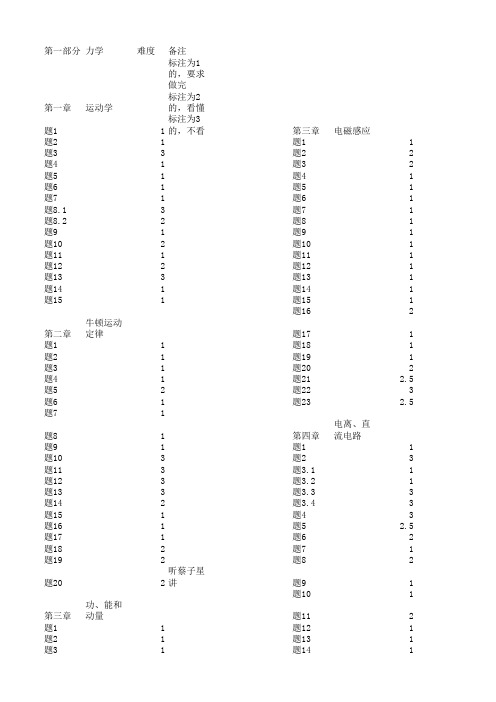
第一部分力学难度备注标注为1的,要求做完第一章运动学标注为2的,看懂题11标注为3的,不看第三章电磁感应题21题11题33题22题41题32题51题41题61题51题71题61题8.13题71题8.22题81题91题91题102题101题111题111题122题121题133题131题141题141题151题151题162第二章牛顿运动定律题171题11题181题21题191题31题202题41题21 2.5题52题223题61题23 2.5题71题81第四章电离、直流电路题91题11题103题23题113题3.11题123题3.21题133题3.33题142题3.43题151题43题161题5 2.5题171题62题182题71题192题82题202听蔡子星讲题91题101第三章功、能和动量题112题11题121题21题131题31题141题42题152题51题16 2.5题61题171题71题183题81题193题92题201题101题211题111题221题122题231题131题241题141题251题151题261题161题273题171题281题181题291题191题301题201题311题211题321题222题331题231题341题241题351题251题261第五章交流电路,暂态过程及其他题271题11题281题22题291题31题302题41题311题51题321题61题331题73题341题81题352题92题361题101题373题113题382题122题39 2.5题133题143第四章角动量,有心运动题153题12题163题22题173题31题181题41题193题51题20.11题61题20.21题72题20.32题81题91第四部分光学题101第一章几何光学题111题11题12 2.5题21题132题31题142题41题51第五章题61题11题72题21题82题31题93题41题103题51题112题61题122题71题131题81题141题92题151题101题161题112题171题123题181题191第六章刚体动力学题201题11题211题2 2.5题221题3 2.5题231题4 2.5题241题5 2.5题251题6 2.5题262题71题272题82题281题91题29题103题302题112题312题122题321题13 2.5题332题14 2.5题34 2.5题152题352题162题363题172题373题182题381题191题393题20 2.5题403题212题41 2.5题222题423题233题242第二章光的干涉题253题11题262题23题272题31题41第七章振动与波动题53题11题61题21题71题31题83题41题93题52题101题62题111题73题122题8 2.5题132题93题143题102题151题111题162题122题172题132题182题142题192题152题203题163题213题172题223题183题233题191题242题20 1.5题253题212题263题222题273题233题242第三章光的衍射题252题13题262题23题273题33题282题43题293题53题303题63题313题73题323题83题332题93题342题103题352题113题362题123题372题133题383题143题391题153题401题163题41 2.5题173题421题182题431题193题203第二部分热学题213第一章平衡态 理想气体状态方程题223题12题21第四章光的偏振题32题11题41题22题51题33题61题43题71题53题81题63题91题73题103题83题112题93题121题103题131题113题141题123题151题133题161题143题153第二章热力学第一、第二定律题163题12题173题23题183题31题193题42题203题51题212题62题222题71题233题81题243题91题253题101题263题111题272题122题283题132题292题142题30 2.5题152题312题162题323题171题333题183题343题191题35 2.5题202题212第五章光的色散,散射和吸收题221题12题233题2 2.5题243题33题253题42题53第三章气体动理论题63题11题73题21题83题32题93题41题103题5 2.5题112题63题73第五部分近代物理题82第一章量子物理题93题11题102题21题11 2.5题31题122题41题131题51题142题63题152题7.11题163题7.23题173题81题182题91题193题101题202题111题213题121题221题1311题232题1411题242题152题253题161题263题172题273题181题283题192题293题203题303第二章狭义相对论第四章范德瓦耳斯气体 液体 固体 相变题11题13题21题23题31题33题41题41题5 2.5题52题63题61题73题71题82题81题93题93题102题101题113题113题123题12.11题133题12.21题14.11题12.32题14.22题13 2.5题151题141题163题152题172题161题181题173题191第三部分电磁学第六部分试题第一章静电场,导体与介质力学试题(一)题11题11题21题21题33题31题41题41题51题51题61题62题71力学试题(二)题8.11题11题8.22题2 1.5题91题31题102题43题111题53题121题6 2.5题132热学试题(一)题142题13题151题2.11题161题2.23题171题32题181题42题191题53题202热力学试题(二)题212题11题223题23题232题31题241题43题252题5 2.5题261电磁学试题(一)题271题11题281题22题291题31题302题41题313题52题321电磁学试题(二)题333题12题341题22题352题33题36 2.5题41题371题51题381电磁学试题(三)电路题391题12题401题21题413题3 2.5题421题41题431题53题443电磁学试题(四)电路题45 2.5题13题461题22题32第二章磁场,磁介质题43题11题53题23光学试题题32听蔡子星讲题11题43题21题51题31题61题41题72题52题82题62题91近代物理试题题103题12题113题21题101题31题111题41题121题51题131综合试题(一)题142题11题152题21题16.11题33题16.21题42题16.33题52题172题61题18.11综合试题(二)题18.21题12题18.33题21题191题32题201题41题211题51题223题6.11题233题6.22题241题6.32题253综合试题(三)题26 2.5题11题27 2.5题21题32题4 2.5题51题61综合试题(四)题13题21题33题42题52题6 2.5综合试题(五)题11题21题31题41题51题63听蔡子星讲(某个公式)过程及其他和吸收。
蔡子星难题集萃难度分级表格范本

第一部分力学难度 备注标注为1的,要求做完第一章 运动学标注为2的,看懂题11 标注为3的,不看题19 2题202听蔡子星讲第三章 功、能和动量 题11题21题31题42题51题61题71题12题35 2 题36 2 题37 2 题38 3 题39 1 题40 1 题41 2.5 题42 1 题431题15 2题16 2题17 1题18 3题19 1题20 2题21 2题22 1题23 3第四章 范德瓦耳斯气体 液体 固体 相变题1 3题2 3题3 3题4 1题5 2题6 1题7 1题8 1题93题202题212题223题232题241题252题261题271题281题291题16.21题16.33题172题18.11题18.21题18.33题191题201题211题3.1 1题3.2 1题3.3 3题3.4 3题4 3题5 2.5题6 2题7 1题8 2题16 1 题17 1 题18 1 题19 1 题20 1 题21 1 题22 1 题23 1 题16 2 题17 2 题18 2 题19 2 题20 3 题21 3 题22 3 题23 3题26 3 题273第三章 光的衍射题13 题23 题33 题43题73 题83 题93 题103 题113 题123 题133题16 3题17 3题18 3题19 3题20 3题21 2题22 2题23 3第一章 量子物理题1 1题2 1题3 1题4 1题5 1题7.2 3题8 1题9 1题10 1题11 1题12 1题13 11题14 11题152题18 1题19 1第六部分试题力学试题(一)题1 1题2 1题3 1题62力学试题(二)题11题21.5题31题43题53题62.5热学试题(一)题12题21题32.5题41题53电磁学试题(四)电路 题13题22题32题43 题53 光学试题题11 题21 题31 题41 题52 题62近代物理试题题42.5 题51 题61 综合试题(四)题13 题21 题33 题42 题52题62.5综合试题(五)题11 题21 题31 题41 题51 题63。
初中物理各学期各层次学生学习难点及课外学习方案建议表(03版)
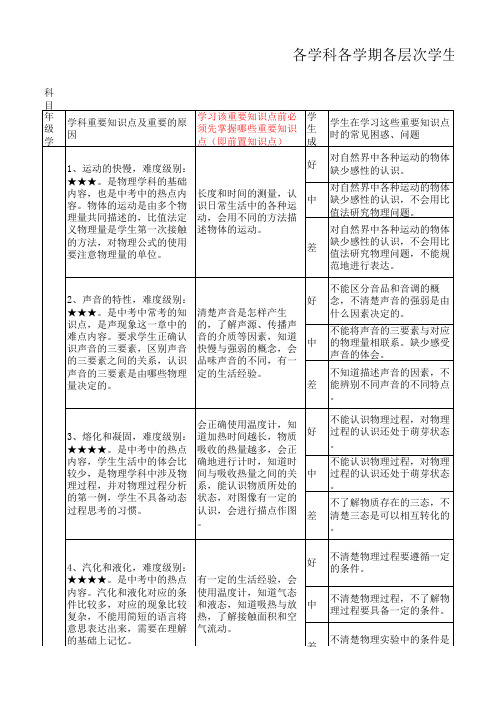
各学科各科较灵活。
差复杂,不能用简短的语言将意思表达出来,需要在理解的基础上记忆。
初二上学期热,了解接触面积和空气流动。
个难点。
与液体的质量,会正确使用量筒测量液体的体积,会正确使用密度公的重点与热点内容。
对测量性物理实验的要求较高,同时还涉及多种测量的误差分的方法是考试中常考的知识点,液体中某一点向各个方向都有压强且压强的大小相的公式进行计算,知道密度的概念,知道深度的含义。
初二下学期★★★★。
是中考中的重点接结合起来,难以把握串、并联电路的特点。
★★★★。
是初中物理中的一个重点内容,中考中必考的知识点。
在电路中电流、压、电阻间的关系,知道电流、电压、电阻的基础。
情境比较抽象,涉及到的物理量也比较多。
学生不容易把握电路图中电路元用,了解电路的必要元素,知道构成一个回路的方法,知道电源与用电器的概念,知道电流考中必考的知识点,容易与电功混淆,不能区分实际功率与额定功率之间的关系,学生对单位时间内电流做的电功的概念,知道时间及时间的测量,了解日常生活中一些常用的用电器,知道电能与其它初三全一册★★。
这是中学物理电学中对日常用电虽然经常接触,但具体使用时对用电的常识与安全知识的本质了解并不多,对一些常识性的知识没能使用时的电路结构,了解日常用电器、开关、插座的结构。
学科各学期各层次学生学习难点及课外学习方案建议表个方向都有压强,且各个方向的压强相等不理解,不会用控制变量法研究问题。
不能从实验中体会液体压强进行求解。
的关系。
识。
八年级物理难题集锦

八年级物理难题集锦第一章. 声现象1. 声音是什么1. 人们常用这样一句话来形容自行车的破旧:“除了铃铛不响,哪儿都响”。
你知道“哪儿都响”的原因吗?给你一辆这样的自行车,你将如何改造,来减少它在进行中的响声?答:因为自行车使用时间长后,会产生螺丝松动,一些不见因长时间摩擦而变形。
在改造过程中,可以将松动的螺丝加上垫圈拧紧,休整变形的振动和摩擦。
2. 在我国云南生长着一种神奇的“跳舞草”,每当音乐响起时,它的叶子就会随着音乐旋律的高低快慢而上下跳动,音乐的节奏变快,它就跳动的快,音乐的节奏一慢,它也随之慢下来,音乐停止时,它也就停止了跳舞,“跳舞草”的神奇表现与声现象有关系吗?简单阐述理由。
答:有关系。
因为这种叶子对声波的刺激十分敏感,音乐的响起将声音传播到空中,然后声音再由空气传播到叶子,使叶子发生振动。
3. “黄河大合唱”歌词中的“风在吼”,“马在叫”,“黄河在咆哮”,这里的“吼”,“叫”,“咆哮”的声源分别是风的声音,马的声带,黄河水。
4. 人靠耳朵听声音,人们干支声音的基本过程即外界传来的声音引起耳膜振动,这种振动经过听小骨及其它组织传给听觉神经,听觉神经把信号传给大脑,这样人就听到了声音。
5. 参照下面的声速,你能得出什么结论?几种物质的声速/(m/s)空气(15℃)340 蒸馏水(25℃)1531空气(25℃)346 铜棒3750软木500 大理石3810煤油(25℃)1324 铝棒5000蒸馏水(15℃)1497 铁棒5200答:声速与材料和气温有关。
5. 2002年暑假期间,北京大学五名学生到珠穆朗玛峰登山,发生雪崩事件,造成重大事故。
登山运动员都知道:雪地等山,不宜高声喊叫。
你能分析其中的原因吗?答:因为雪山或溶洞中的支撑部分可能十分脆弱,高声喊叫会引起空气的振动,当空气振动的频率与雪堆岩石固有的频率达成共振时,会引起雪崩或溶洞塌陷。
6. 音乐家贝多芬耳聋听不到声音,但他用牙咬住木棒的一端,另一端顶在钢琴上,照样创作出传世之作,这是怎么回事?分析:贝多芬耳聋只是传导障碍,听觉神经并没有损坏,用牙咬住木棒一端,另一端顶在钢琴上,可以让钢琴声通过木棒传到牙齿,再通过颌骨,头骨传到听觉神经,引起听觉。
蔡子星难题集萃难度分级表格范本
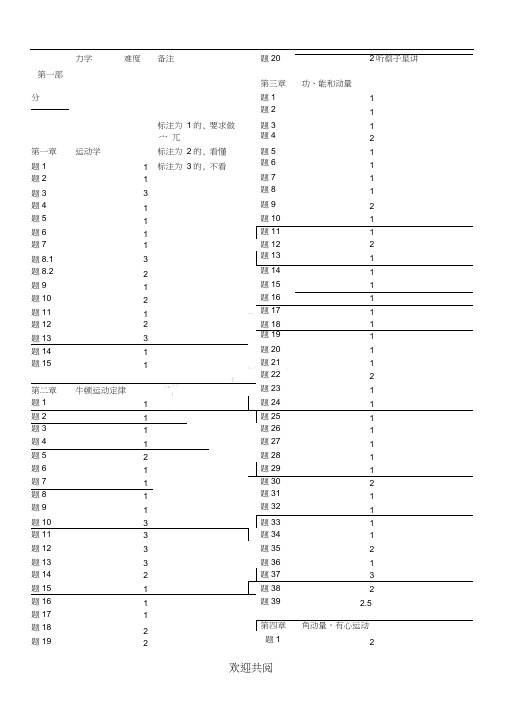
力学难度备注题20 2听蔡子星讲第一部第三章功、能和动量分题1 1题2 1标注为1的,要求做题3 1宀兀题4 2第一章运动学标注为2的,看懂题5 1题6 1题1 1 标注为3的,不看题2 1 题7 1题8 1题3 3题4 1 题9 2题5 1 题10 1题6 1 题11 1题7 1 题12 2题13 1题8.1 3题8.2 2 题14 1题9 1 题15 1题10 2 题16 1题11 1 _题17 1题12 2 题18 1题19 1题13 3题14 1 题20 1题15 1'■ .-1题21-------------------------- !—11题22 2第二章牛顿运动定律 A ■.f Ti _题23 1 题1 1 题24 1 题2 1 7、、题25 1 题3 1 题26 1 题4 1 题27 1 题5 2 题28 1 题6 1 题29 1 题7 1 题30 2 题8 1 题31 1 题9 1 题32 1 题10 3 题33 1 题11 3 题34 1 题12 3 题35 2 题13 3 题36 1 题14 2 题37 3 题15 1 题38 2 题16 1 题39 2.5 题17 1题18 2 第四章角动量,有心运动题1题19 2 2题4 1 题19 1题5 1 题20 2.5题6 1 题21 2题7 2 题22 2题8 1 题23 3题9 1 题24 2题10 1 题25 3题11 1 题26 2题12 2.5 题27 2题13 2题14 2 第七章振动与波动题1 1第五章题2 1题1 1 「题3 1题2 1 题4 1题3 1 题5 2题4 1 题6 2题5 1 题7 3题6 1 题8 2. 5 题7 1 题9 3题8 1 题10 2题9 2 ■■■■T 题11 1题10 1 题12 2题11 2 题13 2题12 3 题14 2# r■兀世了「- 、、、题15 2第六章刚体动力学题16 3题1 1 题17 2题2 2.5 题18 3题3 2.5 题19 1题4 2.5 题20 1.5题5 2.5 题21 2题6 2.5 题22 2题7 1 题23 3题8 2 题24 2题9 1 [题25 2题10 3 题26 2题11 2 题27 3题12 2 题28 2题13 2.5 题29 3题14 2.5 题30 3题15 2 题31 3题16 2 题32 3题35 2 题15 2题36 2 题16 2题37 2 题17 1 题38 3 题18 3题15 2题16.1 1题16.2 1题16.3 3题17 2题18.1 1题18.2 1题18.3 3题19 1题20 1题21 1题22 3题23 3题24 1题25 3题26 2.5题27 2.5第三章电磁感应题1 1题2 2 '1题3 2题4 1题5 1 「题6 1题7 1题8 1题9 1 '■亍―—题10 1题11 1题12 1题13 1题14 1题15 1题16 2题17 1题18 1题19 1题20 2题21 2.5题22 3题23 2.5 第四章电离、直流电路题1 1题2 3题 3.1 1题 3.2 1题 3.3 3题 3.4 3题4 3题 5 2.5题6 2题7 1题8 2题9 1题10 1题11 2题12 1题13 1题14 1题15 2题16 2.5题17 1题18 3题19 3题20 1题21 1题22 1题23 1题24 1题25 1题26 1题27 3题28 1题29 1题30 1题31 1题32 1题33 1题34 1题35 1第五章交流电路,暂态过程及其他题1 1题2 2 [题3 1题8 1题9 2题10 1题11 3题12 2题13 3题14 3题15 3题16 3题17 3题18 1题19 3题20.1 1题20.2 1题20.3 2第四部分光学第一章几何光学题1 1题2 1 1题3 1 ■—一、 /题4 1题5 1题6 1题7 2题8 2题9 3题10 3题11 2题12 2题13 1题14 1题15 1题16 1题17 1题18 1题19 1题20 1题21 1题22 1题23 1 [题26 2 题27 2 题28 1 题29 1 题30 2 题31 2 题32 1 题33 2 题34 2.5 题35 2 题36 3 题37 3 题38 1 题39 3 题40 3 题41 2.5 题42 3 第二章光的干涉题1 1 题2 3 题3 1 题4 1 题5 3 题6 1 题7 1 [题8 3 题9 3 题10 1 题11 1 「题12 2 题13 2 题14 3 题15 1 题16 2 题17 2 题18 2 题19 2 题20 3 题21 3 题22 3 题23 3题263 题273第三章 光的衍 射题13 题23 题33 题43 题53 题63 题73 题83 题93 题103 题113 题123 题133 题143 题153题16 3 题17 3 题18 3 题19 3 题203 题21 2 题22 2 题23 3 题24 3 题25 3 题26 3 题27 2 题28 3 题29 2 题30 2.5 题31 2 题32 3 题33 3 题34 3 题352.5第四章 光的偏 振 题6 3 题7 3 题8 3 题9 3 题10 3 题11 3 题12 3 题1333 题5 3 题1 2题22.5 听蔡子星讲 题33 题42 题53 题63题73 题83题93 题103题112第五部 分近代物 理第一章 量子物 理题11 题21 题31 题41 题51第五章 光的色散,散射和吸收题6 3 题7.1 1 题7.2 3 题8 1 题9 1 题10 1 题11 1 题12 1 题13 11 题14 11 题15 2 题16 1 题17 2 题18 1 题19 2 题20 3第二章狭义相对论题1 1 题2 1 题3 1 题4 1 题 5 2.5 题6 3 题7 3 题8 2 题9 3 题10 2 题11 3 题12 3 题13 3 题14.1 1 题14.2 2 题15 1 题16 3 题17 2 题18 1 题19 1第六部试题分力学试题(一)题1 1 题2 1题4 1 题5 1 题6 2题1 1 题2 1.5 题3 1 题4 3 题5 3 题6 2.5 热学试题(一)题1 3 题2.1 1 题2.2 3 题3 2 题4 2 题5 3 热力学试题(二)「题1 1 题2 3 题3 1 题4 3 题5 2.5 电磁学试题(一)题1 1 题2 2 [题3 1 题4 1 题5 2 电磁学试题(二)[题1 2 题2 2 [题3 3 题4 1 题5 1 电磁学试题(三)电路题1 2 题2 1 题3 2.5 题4 1 题5 3题1 3 题2 2 题3 2 力学试题(二)电磁学试题(四)电路题3 1题4 3 题6 2.5题5 3 综合试题(五)光学试题1 1题题2 1题1 1 题3 1题2 1 题4 1题3 1 题5 1题4 1 题6 3题5 2题6 2近代物理试题题1 2题2 1题3 1题4 1题5 1 二二、匕;U -综合试题(一)题1 11 --— - \ \题2 1题3 3 —1 ... 厂1, 、、|题4 2 "'1 \ --1—. \\\ 二题5 2 \ \ 1 *题6 1综合试题(二)题1 2\ | 1 (_•'题2 1题3 2题4 1题5 1题6.1 1题6.2 2题6.3 2综合试题(三)题1 1题2 1题3 2题4 2.5题5 1题6 1综合试题(四)题1 3题2 1题3 3题4 2题5 2。
高中物理难题集锦

高中物理难题集锦1.如图所示,在平行板电容器的两板之间,存在相互垂直的匀强磁场和匀强电场,磁感应强度B1=0.40T,方向垂直纸面向里,电场强度E=2.0×105V/m,PQ为板间中线.紧靠平行板右侧边缘xOy坐标系的第一象限内,有垂直纸面向外的匀强磁场,磁感应强度B2=0.25T,磁场边界AO和y轴的夹角∠AOy=45°.一束带电量q=8.0×10-19C的同位素正离子从P点射入平行板间,沿中线PQ做直线运动,穿出平行板后从y轴上坐标为(0,0.2m)的Q点垂直y轴射入磁场区,离子通过x轴时的速度方向与x轴正方向夹角在45°~90°之间,不计离子重力,求:【小题1】离子运动的速度为多大?【小题2】x轴上被离子打中的区间范围?【小题3】离子从Q运动到x轴的最长时间?【小题4】若只改变AOy区域内磁场的磁感应强度大小,使离子都不能打到x轴上,磁感应强度大小B2´应满足什么条件?答案:【小题1】v=5.0×105m/s【小题2】0.1m≤x≤【小题3】【小题4】B2´≥0.60T解析:(1):离子在两板间时有:解得:v=5.0×105m/s(2)当通过x轴时的速度方向与x轴正方向夹角为45°时,到达x轴上的M点,如图所示,则:r1="0.2m " 所以:OM=当通过x轴时的速度方向与x轴正方向夹角为90°时,到达x轴上的N点,则:r2="0.1m " 所以:ON=r2="0.1m "所以离子到达x轴的区间范围是0.1m≤x≤(3)所有离子速度都相同,当离子运动路程最长时,时间也最长,由图知当r=r1时离子运动时间最长,则:t m=(4)由牛顿第二定律有:则:当r=r1时,同位素离子质量最大:若质量最大的离子不能穿过直线OA,则所有离子必都不能到达x轴,由图可知使离子不能打到x轴上的最大半径:设使离子都不能打到x轴上,最小的磁感应强度大小为B0,则解得B0=="0.60T " 则:B2´≥0.60T2.为了有效地将重物从深井中提出,现用小车利用“双滑轮系统”(两滑轮同轴且有相同的角速度,大轮通过绳子与物体相连,小轮通过另绳子与车相连)来提升井底的重物,如图所示。
10大物理学难题困扰世界
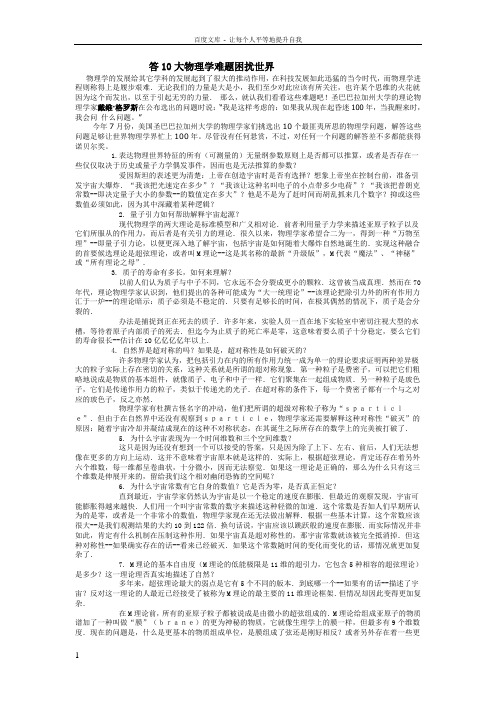
答10大物理学难题困扰世界物理学的发展给其它学科的发展起到了很大的推动作用,在科技发展如此迅猛的当今时代,而物理学进程则称得上是履步艰难.无论我们的力量是大是小,我们至少对此应该有所关注,也许某个思维的火花就因为这个而发出,以至于引起无穷的力量.那么,就认我们看看这些难题吧!圣巴巴拉加州大学的理论物理学家戴维·格罗斯在公布选出的问题时说:“我是这样考虑的:如果我从现在起昏迷100年,当我醒来时,我会问什么问题。
”今年7月份,美国圣巴巴拉加州大学的物理学家们挑选出10个最匪夷所思的物理学问题,解答这些问题足够让世界物理学界忙上100年。
尽管没有任何悬赏,不过,对任何一个问题的解答差不多都能获得诺贝尔奖。
1.表达物理世界特征的所有(可测量的)无量纲参数原则上是否都可以推算,或者是否存在一些仅仅取决于历史或量子力学偶发事件,因而也是无法推算的参数?爱因斯坦的表述更为清楚:上帝在创造宇宙时是否有选择?想象上帝坐在控制台前,准备引发宇宙大爆炸.“我该把光速定在多少”?“我该让这种名叫电子的小点带多少电荷”?“我该把普朗克常数--即决定量子大小的参数--的数值定在多大”?他是不是为了赶时间而胡乱抓来几个数字?抑或这些数值必须如此,因为其中深藏着某种逻辑?2. 量子引力如何帮助解释宇宙起源?现代物理学的两大理论是标准模型和广义相对论.前者利用量子力学来描述亚原子粒子以及它们所服从的作用力,而后者是有关引力的理论.很久以来,物理学家希望合二为一,得到一种“万物至理”--即量子引力论,以便更深入地了解宇宙,包括宇宙是如何随着大爆炸自然地诞生的.实现这种融合的首要候选理论是超弦理论,或者叫M理论--这是其名称的最新“升级版”,M代表“魔法”、“神秘”或“所有理论之母”.3. 质子的寿命有多长,如何来理解?以前人们认为质子与中子不同,它永远不会分裂成更小的颗粒.这曾被当成真理.然而在70年代,理论物理学家认识到,他们提出的各种可能成为“大一统理论”--该理论把除引力外的所有作用力汇于一炉--的理论暗示:质子必须是不稳定的.只要有足够长的时间,在极其偶然的情况下,质子是会分裂的.办法是捕捉到正在死去的质子.许多年来,实验人员一直在地下实验室中密切注视大型的水槽,等待着原子内部质子的死去.但迄今为止质子的死亡率是零,这意味着要么质子十分稳定,要么它们的寿命很长--估计在10亿亿亿亿年以上.4. 自然界是超对称的吗?如果是,超对称性是如何破灭的?许多物理学家认为,把包括引力在内的所有作用力统一成为单一的理论要求证明两种差异极大的粒子实际上存在密切的关系,这种关系就是所谓的超对称现象.第一种粒子是费密子,可以把它们粗略地说成是物质的基本组件,就像质子、电子和中子一样.它们聚集在一起组成物质.另一种粒子是玻色子,它们是传递作用力的粒子,类似于传递光的光子.在超对称的条件下,每一个费密子都有一个与之对应的玻色子,反之亦然.物理学家有杜撰古怪名字的冲动,他们把所谓的超级对称粒子称为“sparticle”.但由于在自然界中还没有观察到sparticle,物理学家还需要解释这种对称性“破灭”的原因:随着宇宙冷却并凝结成现在的这种不对称状态,在其诞生之际所存在的数学上的完美被打破了.5. 为什么宇宙表现为一个时间维数和三个空间维数?这只是因为还没有想到一个可以接受的答案,只是因为除了上下、左右、前后,人们无法想像在更多的方向上运动.这并不意味着宇宙原本就是这样的.实际上,根据超弦理论,肯定还存在着另外六个维数,每一维都呈卷曲状,十分微小,因而无法察觉.如果这一理论是正确的,那么为什么只有这三个维数是伸展开来的,留给我们这个相对幽闭恐怖的空间呢?6. 为什么宇宙常数有它自身的数值?它是否为零,是否真正恒定?直到最近,宇宙学家仍然认为宇宙是以一个稳定的速度在膨胀.但最近的观察发现,宇宙可能膨胀得越来越快.人们用一个叫宇宙常数的数字来描述这种轻微的加速.这个常数是否如人们早期所认为的是零,或者是一个非常小的数值,物理学家现在还无法做出解释.根据一些基本计算,这个常数应该很大--是我们观测结果的大约10到122倍.换句话说,宇宙应该以跳跃般的速度在膨胀.而实际情况并非如此,肯定有什么机制在压制这种作用.如果宇宙真是超对称性的,那宇宙常数就该被完全抵消掉.但这种对称性--如果确实存在的话--看来已经破灭.如果这个常数随时间的变化而变化的话,那情况就更加复杂了.7. M理论的基本自由度(M理论的低能极限是11维的超引力,它包含5种相容的超弦理论)是多少?这一理论理否真实地描述了自然?多年来,超弦理论最大的弱点是它有5个不同的版本.到底哪一个--如果有的话--描述了宇宙?反对这一理论的人最近已经接受了被称为M理论的最主要的11维理论框架.但情况却因此变得更加复杂.在M理论前,所有的亚原子粒子都被说成是由微小的超弦组成的.M理论给组成亚原子的物质谱加了一种叫做“膜”(brane)的更为神秘的物质,它就像生理学上的膜一样,但最多有9个维数度.现在的问题是,什么是更基本的物质组成单位,是膜组成了弦还是刚好相反?或者另外存在着一些更基本的物质单位,只是人们没有想到罢了?最后,这两种东西中是否有一种确实存在,或者M理论仅仅是一种迷人的大脑游戏?8. 黑洞信息悖论的解决方法是什么?根据量子理论,信息--无论它描述的是粒子运动的速度还是油墨颗粒组成文件的确切方式--是不会从宇宙中消失的.但物理学家基普·索恩、约翰·普雷希尔和斯蒡芬·霍金却提出了一个固定的假设:如果你把一本大不列颠百科全书扔进黑洞中去,将会发生什么事?宇宙中是否有其他同样的百科全书是无关紧要的.正如物理学中所定义的,信息并不等同于含义,信息仅指二进制的数字,或是一些其他的代码,它被用来精确地描述一个物体或一种方式.所以看起来那些特定的书本里的信息将被吞没,并永远地消失.但人们觉得这是不可能的.霍金博士和索恩博士相信那些信息确实消失了,而量子力学必须对此作出解释.普雷希尔博士推测信息其实并没有消失;它也许以某种形式显示于黑洞的表面,如同在一个宇宙中的银幕上.9. 何种物理学能够解释基本粒子的重力与其典型质量之间的巨大差距?换言之,为什么重力比其他的作用力(如电磁力)要弱得多?一块磁铁能够吸起一个回形针,即使整个地球的引力在把它往下拉.根据最近的一种说法,重力实际上要大得多.它仅仅是看上去比较弱而已,因为大部分重力陷入了某一个额外的维数度之中.如果我们可以用高能粒子加速器俘获全部的重力,也许就有可能制造出微型黑洞.虽然这看上去会引起固体垃圾处理业的兴趣,但这些黑洞很可能刚一形成就消失了.10. 我们能否定量地理解量子色动力学中的夸克和胶子约束以及质量差距的存在?量子色动力学(QCD)是描述强核子力的理论.这种力由胶子携带,它把夸克结合成质子和中子这样的粒子.根据量子色动力学理论,这些微小的亚粒子永远受到约束.你无法把一个夸克或胶子从质子中分离出来,因为距离越远,这种强作用力就越大,从而迅速地把它们拉回原位.但物理学家还没有最终证明夸克和胶子永远不能逃脱约束.他们也不能解释为什么所有能感受强作用力的粒子必须至少有一丁点儿的质量,为什么它们的质量不能为零.一些人希望M理论能提供答案,这一理论也许还能进一步阐明重力的本质.A 10 physics problems that beset the worldPhysics played a significant role in promoting the development of other disciplines, such a rapid development of science and technology era, the physics processes regarded as difficult to fulfill step. Whether our strength is large or small, at least this should be some concern, perhaps the spark of a thinking because of this issue, the that cause infinite power. Well, we recognize that we take a look at these problems! Said: "I consider this: if I coma 100 years from now, when I woke up, I would ask what theoretical physicist at the University of California, Santa Barbara, David Gross announced elected problems. "In July of this year, physicists at the University of California, Santa Barbara, USA selected 10 of the most puzzling problems of physics, to answer these questions is enough to make the world physics community busy for 100 years. No reward, however, the answer to any one problem can almost won the Nobel Prize.Expression of the characteristics of the physical world all whether the (measurable) dimensionless parameters in principle can be extrapolated, or whether there is some infrequent events depends solely on historical or quantum mechanics, and hence can not be extrapolated to the parameters?Einstein's interpretation is clear: God have a choice in creating the universe? Imagine God sitting at the console, ready to cause the Big Bang. "I take the speed of light set how much"? "I named electronic point with the number of charge"? "I Planck's constant - that determine the quantum size parameters - the values given in much"? He is not to save time for the sake captured a few numbers? Or these values must be so, because deep in some kind of logic?Quantum gravity help explain the origin of the universe?Two great theories of modern physics, the standard model and general relativity. The former quantum mechanics to describe the interactions of subatomic particles and their obedience, while the latter is about the theory of gravitation. A long time, physicists hope into one, a "theory of everything" - that is, the quantum theory of gravity, for more in-depth understanding of the universe, including how the universe is naturally born with the Big Bang. The prime candidate to achieve this convergence theory is superstring theory, called M-theory - this is the latest upgraded version in its name, the M stands for "magic", "mystery" or "the mother of all theories.Lifetime of the proton how long, how to understand?Previously thought protons and neutrons, it will never be split into smaller particles. This has been treated as truth. However, in the 1970s, theoretical physicists recognize that they may be various "Grand Unification Theory" theory - the theory of exchange all outside the gravitational force in a furnace - hint: proton must be not stable. As long as there is asufficient length of time, in the extremely fortuitous circumstances, the proton will be split.Way proton capture are dying. For many years, the laboratory personnel have been in the underground laboratory closely monitor a large sink, waiting for the atomic internal proton died. But so far the mortality rate of the proton is zero, which means that either the proton is very stable, either their long life - estimated at more than 10 billion billion billion billion years.Nature is supersymmetric it? If supersymmetry is how to burst?Many physicists believe that all forces, including gravity, united to form a single theory requires proof that two differences the great particle actually exists a close relationship, this relationship is called supersymmetry phenomenon. The first particles are fermions, they can be loosely described as the basic components of matter, like protons, electrons and neutrons. They gathered material composition. Another particles are bosons, they are passed to the biasing force of particles, similar to the transmission of light photons. Supersymmetry conditions, each fee dense sub has a corresponding boson, and vice versa.Physicists have coined the impulse of the weird name, their so-calledsuper-symmetric particles called "sparticle. But has not been observed in nature to sparticle physicist also need to explain this symmetry "burst" of reasons: as the universe cooled and condensed into this asymmetry state, in its birth exist mathematical perfection was broken.Why universe one time dimension and three spatial dimension?This is simply because also did not expect an acceptable answer, simply because in addition to up and down, left and right, front and back, one can not imagine the movement in more directions. This does not mean that the original is so universe. In fact, according to superstring theory, certainly, there are six other dimension, each dimension were tested curled, very small, and therefore undetectable. If this theory is correct, then why only three dimension extend to the left of our relatively claustrophobic space?Why the cosmological constant is its value? It is zero, really constant?Until recently, cosmologists still think in expansion of the universe is based on a stable speed. But recent observations that the universe may be expanding faster and faster. People use to describe this number called the cosmological constant slight acceleration. Whether this constant as people early that is zero or a very small number, physicists still can not explain. According to some basic calculations, this constant should - is about 10-122 times of our observational results. In other words, the universe should jump-like speed in the expansion. Not the case, certainly what mechanisms to suppress this effect. If the universe is really supersymmetry, that the cosmological constant is due to be fully offset. But this symmetry - if it does exist - seems to have been dashed. If this constant change with the change of time, then the situation is more complex.The low energy limit of M theory degrees of freedom (M theory is 11-dimensional supergravity, it contains five kinds of compatible superstring theory) is how much? The theoretical rationale No truly describe natural?Over the years, superstring theory's biggest weakness is that it has five different versions. Which in the end - if any - to describe the universe? The opponents of this theory has recently been accepted is the most important 11-dimensional theory called M-theory framework. However, the situation has become more complex.Before M-theory, all subatomic particles are said by the tiny superstrings composition. M-theory to the spectrum plus a mysterious substance called "film" (brane), composed of subatomic material like film on the physiology, but up to nine dimension degrees. The question now is, what is the basic substance composed of units, is a film composed of a chord, or just the opposite? Or there is another more basic physical units, but people do not think of nothing? Finally, these two things, whether there is a real existence, or M-theory is just a fascinating brain game?8 What is the solution of the black hole information paradox?According to quantum theory, information - whether it is the speed of the particle motion described or file the exact composition of the ink particles way - will not disappear from the un iverse. Physicist Kip Thorne and John Preskill and Sri Lanka burdock Fen • Hawking has proposed a fixed assumption: If you are one of the Encyclopedia Britannica, go down a black hole, what would happen? The same encyclopedia is irrelevant whether the universe. As defined in physics, the information is not identical to the meaning of the information refers only to the binary number, or some other code, which is used to accurately describe the manner of an object or one. So it looks like those particular books will be swallowed up and lost forever. But people think it isimpossible.Dr. Hawking and Dr. Thorne believe that information does disappear, quantum mechanics must be an explanation. Dr. Preskill, the speculated information is in fact not disappear;it may be displayed in some form on the surface of the black hole, as on the silver screen ina universe.9 what physics can explain the huge gap between the elementary particle of gravitywith its typical quality?In other words, why gravity is much weaker than the other forces (electromagnetic force)? A magnet to pick up a paper clip, even if the gravitational pull of the entire Earth init pulled down.According to the most recent way of saying, gravity is actually much higher. Itjust looks weak only because most of the gravity into an extra dimension several. If we can capturewith high-energy particle accelerators all gravity, perhaps it is possible to create a miniature black hole. While this may seem to cause interest in solid waste disposal industry, these black holes are likely to just one form disappeared.10 Can we quantitatively understand the existence of quarks and gluons in quantum chromodynamics (QCD) constraints, and quality gap?Quantum chromodynamics (QCD), the theory that describes the strong nuclear force.This force by gluons carry, which binds quarks into particles like protons and neutrons. Accordingto the theory of quantum chromodynamics (QCD), these tiny sub-particles to be bound forever. Youcan not put a quark or gluon from the proton separation, because the greater the distance, the greater of such a strong force, which quickly put them back in situ.But physicists have not the ultimate proof that quarks and gluons can never escapethe constraints. They also can not explain why all particles that feel the strong force must beat least a wee bit of quality, why their quality can not be zero. Some people hope that M-theorycan provide an answer, this theory may also be able to further clarify the nature of gravity.解释基本粒子的重力与其典型质量差距云南云维集团大为制焦电仪黄兆荣摘要:本文讲述作者做了大量摩擦实验,通过对实验的分析、论证,说明何种物理学能够解释基本粒子的重力与其典型质量之间的巨大差距?摩擦并不是产生静电,而是给一种比电能量还高的粒子、即具有类似磁的特性、又具有类似电持性、同时还具有电、磁沒有的特性的粒子(吸粒子)加能量,地球通过由吸粒子组成的引力场吸引地球上的任何物质。
10大物理学难题困扰世界(详细版)

物理学家们挑选出10个最匪夷所思的物理学问题,解答这些问题足够让他们忙上100年。
尽管没有任何悬赏,不过,对任何一个问题的解答差不多都能获得诺贝尔奖【美国《纽约时报》8月15日文章】题:需要两千年思考的十大物理学问题(作者乔治·约翰逊)100年前,德因数学家戴维·希尔伯特在巴黎的国际数学家大会上以一番发人深省的话语开始了他划时代的讲话。
他在讲话中罗列了当时尚未解决的23个重大难题。
希尔伯特宣称:“—个伟大时代的结束,不仅要求我们回首过去,而且还引导我们回首对未知的将来进行深思。
”随着又一个世纪——实际上是整整一个千年纪元——的结束,有一种要求显得比以往任何时候更为紧迫,那就是通过罗列最引人入胜的宇宙之谜来显示人类的无知。
今年5月,马萨诸塞州剑桥的克莱数学学会仿效希尔伯特,在巴黎宣布了7道“千年大奖难题”,每道题悬赏100万美元征求解答。
无独有偶,上月,存圣巴巴拉加州大学,物理学家们像通常那样不事张扬地结束了一次有关超弦理论的会议。
他们的最后一次讨论题为“干年疯狂”,议程是挑选出他们领域中10个最匪夷所思的问题。
这就像是一场由科学界最聪明的一批人参加的荒岛游戏。
圣巴巴拉加州大学的理论物理学家戴维·格罗斯在公布选出的问题时说:“我是这样考虑的:如果我从现在起昏迷100年,当我醒来时,我会问什么问题。
”在剔除一些大法问答的问题(例如“怎样获得终身职位?”)后,评委们列出了足够让物理学家忙上100年的难题。
尽管没有任何悬赏,不过,解决下列问题中的任何一个差不多都能保证获得诺贝尔奖。
1.表达物理世界特征的所有(可测量的)无量纲参数原则上是否都可以推算,或者是否存在一些仅仅取决于历吏或量子力学偶发事件,因而也是无法推算的参数?爱因斯坦的表述更为清楚:上帝在创造宇宙时是否有选择?想象上帝坐在控制台前,准备引发宇宙大爆炸。
“我该把光速定在多少?”“我该让这种名叫电子的小点带多少电荷?”“我该把普朗克常数——即决定量子大小的参数——的数值定在多大?”他是不是为了赶时间而胡乱抓来几个数字?抑或这些数值必须如此,因为其中深藏着某种逻辑?2.量子引力如何帮助解释宇宙起源?现代物理学的两大理论是标准模型和广义相对论。
物理学难题集萃

物理学难题集萃
物理学是一门极其复杂的科学,很多物理学问题都属于难题,而难题的汇总及萃取就成为了物理学的一个重要的研究和教学内容。
本文将会综合汇总近年来出现的重要物理学难题,以便于为物理学的学习和研究提供理论和实践的基础。
首先,薛定谔的难题是指由德国理论物理学家薛定谔提出的描述原子波动的算式,同时也是当时著名的量子力学基础理论。
薛定谔算式可以描述原子运动,但其本身存在着许多难以解决的技术和学术问题。
因此,薛定谔的难题便成了物理学界的热议话题之一。
其次,恒星演化的难题是指研究太阳等恒星演化的难题。
恒星演化是一个复杂的过程,了解星体演化过程至关重要,但是,恒星演化机制尚不清楚,需要开展更多的实验来研究获得可靠的理论和实践结果。
第三,黑洞难题是指对黑洞理论本身及其对物理学理论提出的质疑。
黑洞是受重力束缚的极端宇宙体,因其内部的深海沉默,以及其影响的引力场,越来越多的人们开始怀疑它的存在是否符合物理学的规律,这也成为了当今物理学界的一个研究热点。
最后,量子计算难题是指研究量子计算机如何实现超级计算机运算能力的难题。
量子计算机技术是一种新兴的计算机技术,其基于量子力学原理,被认为可以实现超级计算机的运算能力。
但是,如何实现量子计算机的技术以及其能否覆盖所有物理学问题仍有待于进一步研究和测试。
综上所述,物理学的难题集萃具有极大的学习价值和实践价值,从而为物理学的研究提供了更广阔的发展和推动力。
明确物理学难题所涉及的问题,把握和分析当前关于物理学难题的研究热点,以及运用技术和实践来解决这些难题,都是尝试丰富物理学学习体验的方式和手段。
当今物理学界25大难题

David Gross:21世纪物理学的25个难题大卫·格罗斯【①】作者简介:大卫·格罗斯(David Gross),美国国家科学院院士,加州大学圣巴巴拉分校(University of California at Santa Barbara)卡维利理论物理研究所(Kavli Institute for Theoretical Physics )所长。
格罗斯教授是量子色动力学的奠基人之一,当代弦理论专家,因发现强相互作用中的渐近自由现象2004年与弗兰克·维尔切克(Frank Wilczek)和戴维·波利策(David Politzer)分享了当年度的诺贝尔物理学奖。
编者按: 1900年,在巴黎国际数学家代表大会上,德国数学家大卫·希尔伯特(David Hilbert,1864-1943)根据19世纪数学研究成果和发展趋势,提出了新世纪数学家应该致力解决的23个数学问题。
希尔伯特的演讲,对20世纪的数学发展,产生了极大的影响。
100余年之后的2004年,另一个大卫,因发现量子色动力学中的“渐近自由”现象而荣获2004年诺贝尔物理学奖的美国物理学家大卫·格罗斯教授,同样就未来物理学的发展,提出了25个问题。
也许人们会说,在物理学领域提出问题要比数学领域容易得多,因为物理学就像大江大河,而数学则像尼罗河三角洲中纵横交错的河网。
但若是反过来想一想,既然物理学界对前沿问题具有更广泛的共识,我们就不难明白,格罗斯教授所提出的问题对未来物理学发展的重要意义。
有趣的是,这25个问题中,有1/3落在物理学的边缘地带,其中3个与计算机科学相关,3个与生物学相关,4个与哲学和社会学相关。
格罗斯教授的演讲,最初是为美国加州大学卡维利理论物理研究所成立25周年庆典而准备的,该庆典云集了物理学各领域的世界一流学者。
此后数月,格罗斯教授先后在欧洲核子中心(CERN)、中国科学院理论物理研究所、大学等地作过容相近的讲演。
物理竞赛程书题目分级表

P124
P125
P127
P128 P129 P132
P133
P135 P137
P137
P137 P137 P138 P138 P138 P139 P139
P139
P139 P139
习题2-37
2
练习3-1
1
练习3-2
1
练习3-3
1
练习3-4
1
练习3-5
2
练习3-6
1
练习3-7
2
练习3-8
1
练习3-9
1
练习4-12
1
练习4-13
1练习4-141来自练习4-151
练习4-16
3
第五章 能量
P164
P166 P168 P169 P170 P170 P171 P172
P174
P177 P179 P179 P179 P179 P179 P179 P180 P180 P180 P180 P180 P180 P181 P181 P181 P181
习题3-4
1
习题3-5
1
习题3-6
1
习题3-7
1
习题3-8
1
习题3-9
1
习题3-10
1
习题3-11
1
习题3-12
1
第四章 动量
P139
P139 P140
P140
P140
P140
P140 P141 P141 P141
P141
P142
P142 P142 P142 P143 P143
P143
P143 P143
P404
P406 P409 P410 P412 P412 P414 P416 P418 P418 P419 P419 P419 P419
蔡子星难题集萃难度分级表

分题1 1标注为1的,要题做 1宀兀题3 1第一章运动学标注为2的,看懂4 2 题1 1 标注为3的,不题5 1 题2 1 题6 1 题3 3 题7 1 题4 1 题8 1 题5 1 题9 2 题6 1 题10 1 题7 1 题11 1 题8.1 3 题12 2 题8.2 2 题13 1 题9 1 题14 1 题10 2 题15 1 题11 1 题16 1 题12 2 题17 1 题13 3 题18 1 题14 1 题19 1 题15 1 题20 1题21 1 第二章牛顿运动定律题22 2 题1 1 题23 1 题2 1 题24 1 题3 1 题25 1 题4 1 题26 1 题5 2 题27 1 题6 1 题28 1 题7 1 题29 1 题8 1 题30 2 题9 1 题31 1 题10 3 题32 1 题11 3 题33 1 题12 3 题34 1 题13 3 题35 2 题14 2 题36 1 题15 1 题37 3 题16 1 题38 2 题17 1 题39 2.5 题18 2题19 2 第四章角动量,有心运动题20 2 听蔡子星讲题1 2题2 2 第一部力学难度备注第三章功、能和动量题4 1 题18 2 题5 1 题19 1 题6 1 题20 2.5 题7 2 题21 2 题8 1 题22 2 题9 1 题23 3 题10 1 题24 2 题11 1 题25 3题12 2.5 题26 2 题13 2 题27 2题14 2第七章振动与波动第五章题1 1 题1 1 题2 1 题2 1 题3 1 题3 1 题4 1 题4 1 题5 2 题5 1 题6 2 题6 1 题7 3 题7 1 题8 2.5 题8 1 题9 3 题9 2 题10 2 题10 1 题11 1 题11 2 题12 2 题12 3 题13 2题14 2 第六章刚体动力学题15 2题1 1 题16 3 题2 2.5 题17 2 题3 2.5 题18 3 题4 2.5 题19 1 题5 2.5 题20 1.5 题6 2.5 题21 2 题7 1 题22 2 题8 2 题23 3 题9 1 题24 2 题10 3 题25 2 题11 2 题26 2 题12 2 题27 3 题13 2.5 题28 2 题14 2.5 题29 3 题15 2 题30 3 题16 2 题31 3题33 2 题12 2 题34 2 题13 2 题35 2 题14 2 题36 2 题15 2 题37 2 题16 2 题38 3 题17 1 题39 1 题18 3 题40 1 题19 1 题41 2.5 题20 2 题42 1 题21 2 题43 1 题22 1题23 3第二部执学八、、J 题24 3分题25 3第一章平衡态理想气体状态方程题1 2 第三章气体动理论题2 1 题1 1题3 2 题2 1题4 1 题3 2题5 1 题4 1题6 1 题5 2.5 题7 1 题6 3题8 1 题7 3题9 1 题8 2题10 3 题9 3题11 2 题10 2题12 1 题11 2.5 题13 1 题12 2题14 1 题13 1题15 1 题14 2题16 1 题15 2题16 3第二章热力学第、第二定律题17 3题1 2 题18 2题2 3 题19 3题3 1 题20 2题4 2 题21 3题5 1 题22 1题6 2 题23 2题7 1 题24 2题8 1 题25 3题9 1 题26 3题10 1 题27 3题29 3 题17 1题30 3 题18 1题19 1第四章范德瓦耳斯气体液体固体相变题20 2题1 3 题21 2题2 3 题22 3题3 3 题23 2题4 1 题24 1题5 2 题25 2题6 1 题26 1题7 1 题27 1题8 1 题28 1题9 3 题29 1题10 1 题30 2题11 3 题31 3题 12.1 1 题32 1题 12.2 1 题33 3题 12.3 2 题34 1题13 2.5 题35 2题14 1 题36 2.5题15 2 题37 1题16 1 题38 1题17 3 题39 1题40 1第三部电磁学题41 3分题42 1第一章静电场,导体与介质题43 1题1 1 题44 3题2 1 题45 2.5题3 3 题46 1题4 1题5 1 第二章磁场,磁介质题6 1 题1 1题7 1 题2 3题8.1 1 题3 2听蔡子星讲题8.2 2 题4 3题9 1 题5 1题10 2 题6 1题11 1 题7 2题12 1 题8 2题13 2 题9 1题14 2 题10 3题15 1 题11 3题11 1 题21 2.5 题12 1 题22 3 题13 1 题23 2.5 题14 2题15 2 第四章电离、直流电路题 16.1 1 题1 1 题 16.2 1 题2 3 题 16.3 3 题3.1 1 题17 2 题3.2 1 题 18.1 1 题3.3 3 题 18.2 1 题3.4 3 题 18.3 3 题4 3 题19 1 题5 2.5 题20 1 题6 2 题21 1 题7 1 题22 3 题8 2 题23 3 题9 1 题24 1 题10 1 题25 3 题11 2 题26 2.5 题12 1 题27 2.5 题13 1题14 1 第三章电磁感题15 2 应题16 2.5 题1 1 题17 1 题2 2 题18 3 题3 2 题19 3 题4 1 题20 1 题5 1 题21 1 题6 1 题22 1 题7 1 题23 1 题8 1 题24 1 题9 1 题25 1 题10 1 题26 1 题11 1 题27 3 题12 1 题28 1 题13 1 题29 1 题14 1 题30 1 题15 1 题31 1 题16 2 题32 1 题17 1 题33 1 题18 1 题34 1 题19 1 题35 1。
蔡子星难题集萃难度分级表精编版

蔡子星难题集萃难度分级表精编版MQS system office room 【MQS16H-TTMS2A-MQSS8Q8-MQSH16898】第一部分力学难度备注标注为1的,要求做完第一章运动学标注为2的,看懂题1 1 标注为3的,不看题2 1题3 3题4 1题5 1题6 1题7 1题 3题 2题9 1题10 2题11 1题12 2题13 3题14 1题15 1第二章牛顿运动定律题1 1题2 1题3 1题4 1题5 2题6 1题7 1题8 1题9 1题10 3题11 3题12 3题13 3题14 2题15 1题16 1题17 1题18 2题19 2题20 2 听蔡子星讲第三章功、能和动量题1 1题2 1 题4 2 题5 1 题6 1 题7 1 题8 1 题9 2 题10 1 题11 1 题12 2 题13 1 题14 1 题15 1 题16 1 题17 1 题18 1 题19 1 题20 1 题21 1 题22 2 题23 1 题24 1 题25 1 题26 1 题27 1 题28 1 题29 1 题30 2 题31 1 题32 1 题33 1 题34 1 题35 2 题36 1 题37 3 题38 2 题39第四章角动量,有心运动题1 2 题2 2 题3 1 题4 1 题5 1 题6 1 题7 2 题8 1 题9 1 题10 1题12题13 2 题14 2第五章题1 1 题2 1 题3 1 题4 1 题5 1 题6 1 题7 1 题8 1 题9 2 题10 1 题11 2 题12 3第六章刚体动力学题1 1 题2题3题4题5题6题7 1 题8 2 题9 1 题10 3 题11 2 题12 2 题13题14题15 2 题16 2 题17 2 题18 2 题19 1 题20题21 2 题22 2 题23 3 题24 2 题25 3 题26 2 题27 2第七章振动与波动题1 1 题3 1题4 1题5 2题6 2题7 3题8题9 3题10 2题11 1题12 2题13 2题14 2题15 2题16 3题17 2题18 3题19 1题20题21 2题22 2题23 3题24 2题25 2题26 2题27 3题28 2题29 3题30 3题31 3题32 3题33 2题34 2题35 2题36 2题37 2题38 3题39 1题40 1题41题42 1题43 1第二部分热学第一章平衡态理想气体状态方程题1 2题2 1题3 2题4 1题8 1题9 1题10 3题11 2题12 1题13 1题14 1题15 1题16 1第二章热力学第一、第二定律题1 2题2 3题3 1题4 2题5 1题6 2题7 1题8 1题9 1题10 1题11 1题12 2题13 2题14 2题15 2题16 2题17 1题18 3题19 1题20 2题21 2题22 1题23 3题24 3题25 3第三章气体动理论题1 1题2 1题3 2题4 1题5题6 3题7 3题8 2题9 3 题13 1题14 2题15 2题16 3题17 3题18 2题19 3题20 2题21 3题22 1题23 2题24 2题25 3题26 3题27 3题28 3题29 3题30 3第四章范德瓦耳斯气体液体固体相变题1 3题2 3题3 3题4 1题5 2题6 1题7 1题8 1题9 3题10 1题11 3题 1题 1题 2题13题14 1题15 2题16 1题17 3第三部分电磁学第一章静电场,导体与介质题1 1题2 1题3 3题4 1题 1题 2题9 1题10 2题11 1题12 1题13 2题14 2题15 1题16 1题17 1题18 1题19 1题20 2题21 2题22 3题23 2题24 1题25 2题26 1题27 1题28 1题29 1题30 2题31 3题32 1题33 3题34 1题35 2题36题37 1题38 1题39 1题40 1题41 3题42 1题43 1题44 3题45题46 1第二章磁场,磁介质题1 1题2 3题3 2 听蔡子星讲题4 3题5 1 题9 1 题10 3 题11 3 题10 1 题11 1 题12 1 题13 1 题14 2 题15 2 题 1 题 1 题 3 题17 2 题 1 题 1 题 3 题19 1 题20 1 题21 1 题22 3 题23 3 题24 1 题25 3 题26题27第三章电磁感应题1 1 题2 2 题3 2 题4 1 题5 1 题6 1 题7 1 题8 1 题9 1 题10 1 题11 1 题12 1 题13 1 题14 1 题15 1 题16 2 题17 1 题18 1 题19 1题23第四章电离、直流电路题1 1题2 3题 1题 1题 3题 3题4 3题5题6 2题7 1题8 2题9 1题10 1题11 2题12 1题13 1题14 1题15 2题16题17 1题18 3题19 3题20 1题21 1题22 1题23 1题24 1题25 1题26 1题27 3题28 1题29 1题30 1题31 1题32 1题33 1题34 1题35 1第五章交流电路,暂态过程及其他题1 1题2 2题3 1题4 1 题8 1 题9 2 题10 1 题11 3 题12 2 题13 3 题14 3 题15 3 题16 3 题17 3 题18 1 题19 3 题 1 题 1 题 2第四部分光学第一章几何光学题1 1 题2 1 题3 1 题4 1 题5 1 题6 1 题7 2 题8 2 题9 3 题10 3 题11 2 题12 2 题13 1 题14 1 题15 1 题16 1 题17 1 题18 1 题19 1 题20 1 题21 1 题22 1 题23 1 题24 1 题25 1 题26 2 题27 2题31 2 题32 1 题33 2 题34题35 2 题36 3 题37 3 题38 1 题39 3 题40 3 题41题42 3第二章光的干涉题1 1 题2 3 题3 1 题4 1 题5 3 题6 1 题7 1 题8 3 题9 3 题10 1 题11 1 题12 2 题13 2 题14 3 题15 1 题16 2 题17 2 题18 2 题19 2 题20 3 题21 3 题22 3 题23 3 题24 2 题25 3 题26 3 题27 3第三章光的衍射题1 3 题2 3 题6 3 题7 3 题8 3 题9 3 题10 3 题11 3 题12 3 题13 3 题14 3 题15 3 题16 3 题17 3 题18 2 题19 3 题20 3 题21 3 题22 3第四章光的偏振题1 1 题2 2 题3 3 题4 3 题5 3 题6 3 题7 3 题8 3 题9 3 题10 3 题11 3 题12 3 题13 3 题14 3 题15 3 题16 3 题17 3 题18 3 题19 3 题20 3 题21 2 题22 2 题23 3 题24 3 题25 3 题26 3 题27 2题31 2题32 3题33 3题34 3题35第五章光的色散,散射和吸收题1 2题2听蔡子星讲题3 3题4 2题5 3题6 3题7 3题8 3题9 3题10 3题11 2第五部分近代物理第一章量子物理题1 1 题2 1 题3 1 题4 1 题5 1 题6 3 题 1 题 3 题8 1 题9 1 题10 1 题11 1 题12 1 题1311 题1411 题15 2 题16 1 题17 2 题18 1 题19 2 题20 3第二章狭义相对论题1 1 题5题6 3 题7 3 题8 2 题9 3 题10 2 题11 3 题12 3 题13 3 题 1 题 2 题15 1 题16 3 题17 2 题18 1 题19 1第六部分试题力学试题(一)题1 1 题2 1 题3 1 题4 1 题5 1 题6 2 力学试题(二)题1 1 题2题3 1 题4 3 题5 3 题6热学试题(一)题1 3 题 1 题 3 题3 2 题4 2 题5 3 热力学试题(二)题1 1 题2 3 题3 1 题4 3 题5(一)题1 1 题2 2 题3 1 题4 1 题5 2 电磁学试题(二)题1 2 题2 2 题3 3 题4 1 题5 1 电磁学试题(三)电路题1 2 题2 1 题3题4 1 题5 3 电磁学试题(四)电路题1 3 题2 2 题3 2 题4 3 题5 3 光学试题题1 1 题2 1 题3 1 题4 1 题5 2 题6 2 近代物理试题题1 2 题2 1 题3 1 题4 1 题5 1 综合试题(一)题1 1 题2 1 题3 3 题4 2 题5 2 题6 1 综合试题(二)题1 2 题2 1 题4 1 题5 1 题 1 题 2 题 2 综合试题(三)题1 1 题2 1 题3 2 题4题5 1 题6 1 综合试题(四)题1 3 题2 1 题3 3 题4 2 题5 2 题6综合试题(五)题1 1 题2 1 题3 1 题4 1 题5 1 题6 3。
物理最难学的部分高中 哪部分比较难

物理最难学的部分高中哪部分比较难从书目来说选修3最难;从学问上说的话,看你对于每个单独学科的理解力量。
详细哪一部分最难,要看个人的理解程度。
物理最难学的部分有些人觉得力与运动计算难,但是思路比较清楚,简单构筑模型。
有些人觉得电磁难,比较难构筑模型,但计算相对简洁。
还有比如电路,许多人看图就看不明白。
能量相关的计算也会消失功和功率不分或者单位不明的状况。
详细的还要看错题大多出在哪里。
必修1和2:主要是力与运动还有能量转化,这一部分不分文理,但出题多为小题,计算也比较简洁,大题也会出,但比重不大,而且多会结合选修内容出综合类的题。
选修1(主要针对文科生):主要是电、磁、热,讲的很浅显,多为文科选修,选修1的最终一章也是自然科学结合人文科学去讲的,生活中的应用价值还是很值得确定的。
选修2(主要针对理科生):主要是电、磁、力与机械、热与热机,难度较选修1有了很大提升选修3(主要针对物理天才,许多学问高校理科专业你都学不到,一辈子都用不到)学好物理的技巧其实高中物理讲的就是一些自然界当中事物的定理,这些在我们身边还有许多事物都蕴含这这些真理,生活到处都有物理,就比如说我们每次坐车,我们看外面的世界就可以观察这些车子外面的东西都在向后走,这就是我们高中物理当中的参照物,这个学问点,生活处处都存在学问,你要专心去体会。
对于一些定理还有就是一些死概念还有的一些规律你们都要高度重视,但是你不光时要记住这些学问,你要学会该怎样利用起来,这才是关键,聪慧的孩子是利用这些公式然后应用到自己的错题当中,从中找到问题的所在,你还要做到从一个小小的错题,就可以复习到许多学问,真是双丰收,这也是同学学习高中物理能不能开窍的关键。
八年级物理上册重难点概述
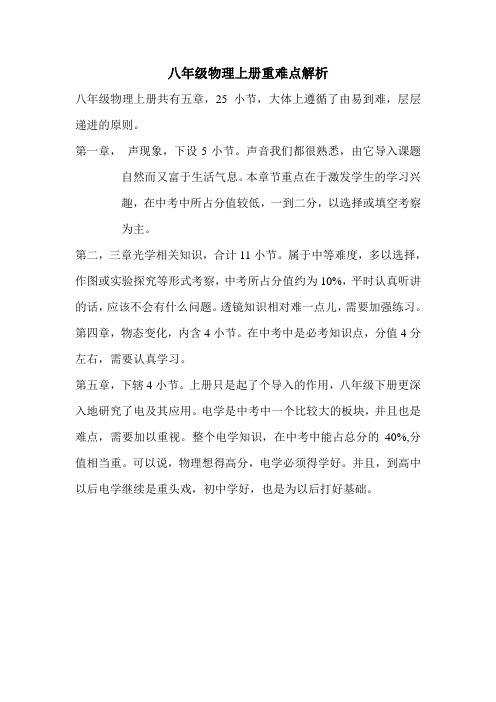
八年级物理上册重难点解析
八年级物理上册共有五章,25小节,大体上遵循了由易到难,层层递进的原则。
第一章,声现象,下设5小节。
声音我们都很熟悉,由它导入课题自然而又富于生活气息。
本章节重点在于激发学生的学习兴
趣,在中考中所占分值较低,一到二分,以选择或填空考察
为主。
第二,三章光学相关知识,合计11小节。
属于中等难度,多以选择,作图或实验探究等形式考察,中考所占分值约为10%,平时认真听讲的话,应该不会有什么问题。
透镜知识相对难一点儿,需要加强练习。
第四章,物态变化,内含4小节。
在中考中是必考知识点,分值4分左右,需要认真学习。
第五章,下辖4小节。
上册只是起了个导入的作用,八年级下册更深入地研究了电及其应用。
电学是中考中一个比较大的板块,并且也是难点,需要加以重视。
整个电学知识,在中考中能占总分的40%,分值相当重。
可以说,物理想得高分,电学必须得学好。
并且,到高中以后电学继续是重头戏,初中学好,也是为以后打好基础。
10大物理学难题困扰世界(详细版)
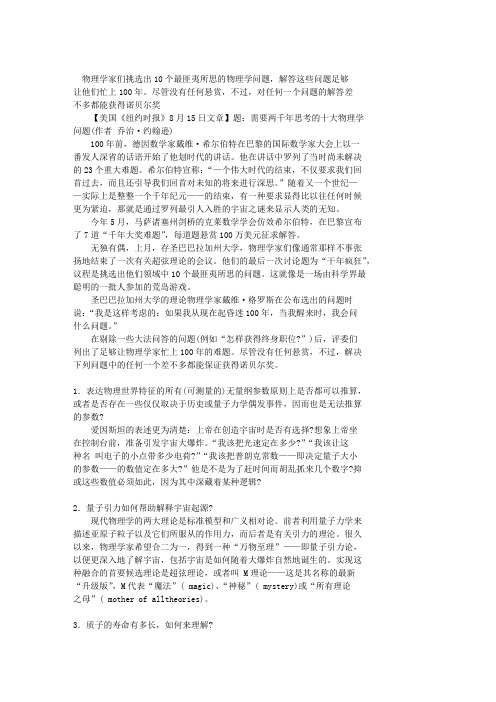
物理学家们挑选出10个最匪夷所思的物理学问题,解答这些问题足够让他们忙上100年。
尽管没有任何悬赏,不过,对任何一个问题的解答差不多都能获得诺贝尔奖【美国《纽约时报》8月15日文章】题:需要两千年思考的十大物理学问题(作者乔治·约翰逊)100年前,德因数学家戴维·希尔伯特在巴黎的国际数学家大会上以一番发人深省的话语开始了他划时代的讲话。
他在讲话中罗列了当时尚未解决的23个重大难题。
希尔伯特宣称:“—个伟大时代的结束,不仅要求我们回首过去,而且还引导我们回首对未知的将来进行深思。
”随着又一个世纪——实际上是整整一个千年纪元——的结束,有一种要求显得比以往任何时候更为紧迫,那就是通过罗列最引人入胜的宇宙之谜来显示人类的无知。
今年5月,马萨诸塞州剑桥的克莱数学学会仿效希尔伯特,在巴黎宣布了7道“千年大奖难题”,每道题悬赏100万美元征求解答。
无独有偶,上月,存圣巴巴拉加州大学,物理学家们像通常那样不事张扬地结束了一次有关超弦理论的会议。
他们的最后一次讨论题为“干年疯狂”,议程是挑选出他们领域中10个最匪夷所思的问题。
这就像是一场由科学界最聪明的一批人参加的荒岛游戏。
圣巴巴拉加州大学的理论物理学家戴维·格罗斯在公布选出的问题时说:“我是这样考虑的:如果我从现在起昏迷100年,当我醒来时,我会问什么问题。
”在剔除一些大法问答的问题(例如“怎样获得终身职位?”)后,评委们列出了足够让物理学家忙上100年的难题。
尽管没有任何悬赏,不过,解决下列问题中的任何一个差不多都能保证获得诺贝尔奖。
1.表达物理世界特征的所有(可测量的)无量纲参数原则上是否都可以推算,或者是否存在一些仅仅取决于历吏或量子力学偶发事件,因而也是无法推算的参数?爱因斯坦的表述更为清楚:上帝在创造宇宙时是否有选择?想象上帝坐在控制台前,准备引发宇宙大爆炸。
“我该把光速定在多少?”“我该让这种名叫电子的小点带多少电荷?”“我该把普朗克常数——即决定量子大小的参数——的数值定在多大?”他是不是为了赶时间而胡乱抓来几个数字?抑或这些数值必须如此,因为其中深藏着某种逻辑?2.量子引力如何帮助解释宇宙起源?现代物理学的两大理论是标准模型和广义相对论。
- 1、下载文档前请自行甄别文档内容的完整性,平台不提供额外的编辑、内容补充、找答案等附加服务。
- 2、"仅部分预览"的文档,不可在线预览部分如存在完整性等问题,可反馈申请退款(可完整预览的文档不适用该条件!)。
- 3、如文档侵犯您的权益,请联系客服反馈,我们会尽快为您处理(人工客服工作时间:9:00-18:30)。
1
题6
2
题5
1
近代物理试题
题6
3
题1
2
题2
1
题3
1
题4
1
题5
1
综合试题(一)
题1
1
题2
1
题3
3
题4
2
题5
2
题6
1
综合试题(二)
题1
2
题2
1
题3
2
3
题15
3
题34
3
题16
3
题35
2.5
题17
3
题18
2
第五章
光的色散,散射和吸收
题19
3
题1
2
题20
3
题2
2.5
题21
3
题3
3
题22
3
题4
2
题5
3
第四章
光的偏振
题6
3
题7
3
题13
3
题8
3
题14.1
1
题9
3
题14.2
2
题10
3
题15
1
题11
2
题16
3
题17
2
第五部分
近代物理
题18
1
第一章
量子物理
题19
2
题2.2
3
题20
3
题3
2
题4
2
第二章
狭义相对论
题5
3
题1
1
热力学试题(二)
题2
1
题1
1
题3
1
题2
3
题4
1
题3
1
题5
2.5
题4
3
题6
3
题5
2.5
题7
3
电磁学试题(一)
题8
2
题1
1
题9
3
题2
2
题10
2
题3
1
题11
3
题4
1
题12
3
题5
2
电磁学试题(二)
题4
1
题1
2
题5
1
题2
2
题6.1
1
题3
3
题6.2
2
题4
3
题10
3
题24
2
题11
2
题25
2
题12
2
题26
2
题13
2.5
题27
3
题14
2.5
题28
2
题15
2
题29
3
题30
3
题9
1
题31
3
题10
1
题32
3
题11
1
题33
2
题12
2
题34
2
题13
2
题35
2
题14
2
题36
2
题15
2
题37
2
题16
2
题38
3
题17
1
题39
1
题18
3
题40
1
题19
1
题41
2.5
题20
2
2
题10
1
题28
1
题11
3
题29
1
题12
2
题30
2
题13
3
题31
2
题14
3
题32
1
题15
3
题33
2
题16
3
题34
2.5
题17
3
题35
2
题18
1
题36
3
题19
3
题37
3
题20.1
1
题38
1
题20.2
1
题39
3
题20.3
2
题40
3
题41
2.5
第四部分
光学
题42
3
第一章
几何光学
题1
1
第二章
光的干涉
题2
1
题1
题13
1
题16
1
题14
2
题15
2
第二章
热力学第一、第二定律
题16
3
题1
2
题17
3
题2
3
题18
2
题3
1
题19
3
题4
2
题20
2
题5
1
题21
3
题6
2
题22
1
题7
1
题23
2
题8
1
题24
2
题25
3
题12
1
题26
3
题13
2
题27
3
题14
2
题28
3
题15
1
题29
3
题16
1
题30
3
题17
1
题18
1
第四章
范德瓦耳斯气体液体固体相变
1
题10
1
题20
2
题11
1
题21
2.5
题12
1
题22
3
题13
1
题23
2.5
题14
2
题15
2
第四章
电离、直流电路
题16.1
1
题1
1
题16.2
1
题2
3
题16.3
3
题3.1
1
题17
2
题3.2
1
题18.1
1
题3.3
3
题18.2
1
题3.4
3
题18.3
3
题4
3
题19
1
题5
2.5
题20
1
题6
2
题21
1
题7
1
题22
1
题3
1
题2
3
题4
1
题3
1
题5
1
题4
1
题6
1
题5
3
题7
2
题6
1
题8
2
题7
1
题9
3
题8
3
题10
3
题9
3
题11
2
题10
1
题11
1
题1
1
题12
2
题2
2
题13
2
题3
3
题14
3
题4
3
题15
1
题5
3
题16
2
题6
3
题17
2
题7
3
题18
2
题8
3
题19
2
题9
3
题20
3
题10
3
题21
3
题11
3
题22
3
题12
3
题23
3
题13
3
题13
1
题28
1
题14
1
题29
1
题15
1
题30
1
题31
1
题12
2
题32
1
题13
1
题33
1
题14
1
题34
1
题15
1
题35
1
题16
1
题17
1
第五章
交流电路,暂态过程及其他
题18
1
题1
1
题19
1
题2
2
题20
1
题3
1
题21
1
题4
1
题22
1
题5
1
题23
1
题6
1
题24
1
题7
3
题25
1
题8
1
题26
2
题9
2
题27
3
题8
2
题23
3
题9
1
题24
1
题10
1
题25
3
题11
2
题26
2.5
题12
1
题27
2.5
题13
1
题14
1
第三章
电磁感应
题15
2
题1
1
题16
2.5
题2
2
题17
1
题3
2
题18
3
题4
1
题19
3
题5
1
题20
1
题6
1
题21
1
题7
1
题22
1
题8
1
题23
1
题9
1
题24
1
题10
1
题25
1
题11
1
题26
1
题12
1
题27
题21
1
题1
1
题22
2
题2
1
题23
1
题3
1
题24
1
题4
1
题25
1
题5
2
题26
1
题6
1
题27
1
题7
1
